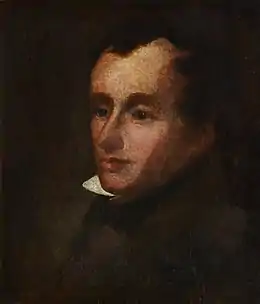John Zephaniah Bell
John Zephaniah Bell, né en 1794 à Dundee et mort en 1883, est un peintre écossais.

| Naissance | |
|---|---|
| Décès |
(à 88 ans) |
| Nationalité | |
| Formation | |
| Activité | |
| Période d'activité |
- |
| Maître | |
|---|---|
| Genre artistique |
Biographie
John Zephaniah Bell naît en 1794 à Dundee[1], où son père William Bell est tanneur, homme d’affaires et banquier. L'aventurier James Stanislaus Bell (en) est son frère. Il étudie à l'Université d'Edimbourg, puis se rend à Londres où il est l'élève de Martin Archer Shee[2] - [3] - [4].
Bell étudie auprès d'Antoine-Jean Gros à Paris, et séjourne à Rome pendant plus d'un an à partir de 1825. Il est portraitiste de Maria II du Portugal et assistant de David Wilkie. Il épouse Jane Graham Hay Campbell en 1831[3] - [5].
Bell devient directeur de la Manchester School of Design lors de sa fondation en 1838[3] - [6]. Il démissionne en 1843 et est remplacé par George Wallis[7].
Œuvres
À Paris, Bell rencontre David Ogilvy, 9ème comte d’Airlie, qui devient son mécène et lui fait décorer le château de château de Cortachy[3]. Il expose des peintures à la Royal Academy et à la Royal Manchester Institution de 1824 à 1865[8]. Les fresques du manoir Muirhouse à Édimbourg impressionnent Wilkie[9]. Bell remporte un prix au concours de fresques du Westminster Hall de 1842[3] - [6].
Bell est un Sandemanian et peint un portrait de Michael Faraday, de la même église[10]. L'œuvre John Gubbins Newton and His Sister, Mary Newton (en) lui était attribuée à tort[11].
Notes et références
- (en) Cet article est partiellement ou en totalité issu de l’article de Wikipédia en anglais intitulé « John Zephaniah Bell » (voir la liste des auteurs).
- (en) « Bell, John Zephaniah », extrait de la notice dans le dictionnaire Bénézit
 , sur Oxford Art Online, (ISBN 9780199773787)
, sur Oxford Art Online, (ISBN 9780199773787) - (en) James Elton Bell et Frances Jean Bell, Sir Robert Bell and His Early Virginia Colony Descendants : A Compilation of 16th, 17th, and 18th Century English and Scottish Families With the Surname Bell, Beale, Le Bel, et al., Wheatmark, , 173 p. (ISBN 978-1-58736-747-2, lire en ligne), p. 97
- (en) National Gallery (Grande Bretagne), « Bell (John Zephaniah) », dans Descriptive and Historical Catalogue of the Pictures. British schools, (lire en ligne), p. 28
- (en) Dmitry Fedosov et University of Aberdeen. Centre for Scottish Studies, The Caledonian connection : Scotland-Russia ties : Middle Ages to early twentieth century : a concise biographical list, Centre for Scottish Studies, University of Aberdeen, , 122 p. (ISBN 978-0-906265-22-2, lire en ligne), p. 11
- (en) Stuart MacDonald, History And Philosophy Of Art Education, James Clarke & Co., , 400 p. (ISBN 978-0-7188-9153-4, lire en ligne), p. 85
- (en) Martin Hewitt, Victorian World, Routledge, , 756 p. (ISBN 978-0-415-49187-7, lire en ligne), p. 588
- (en) Franz Bosbach, William Filmer-Sankey et Hermann Hiery, Prinz Albert und die Entwicklung der Bildung in England und Deutschland im 19. Jahrhundert : Prince Albert and the Development of Education in England and Germany in the 19th Century, Walter de Gruyter, , 256 p. (ISBN 978-3-11-095440-1, lire en ligne), p. 113
- (en) « John Zephaniah Bell letters, 1829-1843. »
- (en) « John Zephaniah Bell », sur scottish-places.info
- (en) Melville Y. Stewart, Science and Religion in Dialogue, Two Volume Set, John Wiley & Sons, , 1168 p. (ISBN 978-1-4443-1736-7, lire en ligne), p. 347
- (en) « Who was Robert Burnard ? Angus Trumble investigates the mystery of a double portrait painted in about 1833 by Robert Burnard, a Cornish painter who emigrated to Australia in 1839. Its remarkable quality has in the past led to an attribution to Agasse--so why are no other paintings by Burnard known in England ? », sur thefreelibrary.com
Liens externes
- Ressources relatives aux beaux-arts :
- Tate
- (en) Art UK
- (en) Bénézit
- (en) British Museum
- (en) MutualArt
- (nl + en) RKDartists
- (en) Union List of Artist Names